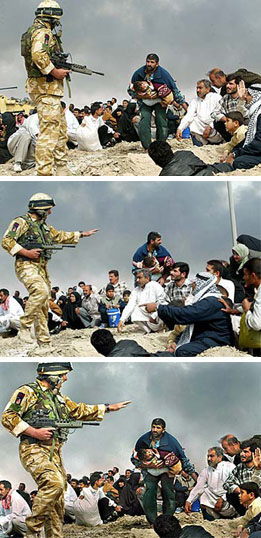Image Forensics

The trustworthiness of photographs has an essential role in many areas, including: forensic investigation, criminal investigation, surveillance systems, intelligence services, medical imaging, and journalism. The art of making image fakery has a long history. But, in today’s digital age, it is possible to very easily change the information represented by an image without leaving any obvious traces of tampering. Despite this, no system yet exists which accomplishes effectively and accurately the image tampering detection task.
The digital information revolution and issues concerned with multimedia security have also generated several approaches to digital forensics and tampering detection. Generally, these approaches could be divided into active and passive–blind approaches. The area of active methods simply can be divided into the data hiding approach (e.g., watermarks) and the digital signature approach. We focus on blind methods, as they are regarded as a new direction and in contrast to active methods, they work in absence of any protecting techniques and without using any prior information about the image. To detect the traces of tampering, blind methods use the image function and the fact that forgeries can bring into the image specific detectable changes (e.g., statistical changes).
When digital watermarks or signatures are not available, the blind approach is the only way how to make the decision about the trustworthiness of the investigated image. Image forensics is a burgeoning research field and promise a significant improvement in forgery detection in the never–ending competition between image forgery creators and image forgery detectors.
Topics
When two or more images are spliced together , to create high quality and consistent image forgeries, almost always geometric transformations such as scaling, rotation or skewing are needed.
Geometric transformations typically require a resampling and interpolation step. Thus, having available sophisticated resampling/interpolation detectors is very valuable.
In a common type of digital image forgery, called copy–move forgery, a part of the image is copied and pasted into the another part of the same image, typically with the intention to hide an object or a region . The copy–move forgery brings into the image several near–duplicated image regions.
A commonly used tool to conceal traces of tampering is addition of locally random noise to the altered image regions. This operation may cause inconsistencies in the images noise . Therefore, the detection of various noise levels in an image may signify tampering.
The term cyclostationarity refers to a special class of signals (cyslostationary signals) which exhibit periodicity in their statistics. Employing the existing efficient cyclostationary detectors to find the traces of geometric transformation shows promising results.
| Details: | |
| Duration: | 2008 - 2010 |
| Contact person: | Stanislav Saic |
| Involved people: | Babak Mahdian, Tomáš Suk |
Publications:
- B.Mahdian, R. Nedbal, S. Saic. JPEG Quantization Tables Forensics: A Statistical Approach. 4th International Workshop on Computational Forensics. Pages: 145 - 154. November 11-12, 2010, Tokyo, Japan. Lecture notes in computer science, Springer.
- B. Mahdian and S. Saic: A bibliography on blind methods for identifying image forgery , Signal Processing-Image Communication vol.25, 6 (2010), p. 389-399.
- B. Mahdian, S. Stanislav: Blind Methods for Detecting Image Fakery , IEEE Aerospace and Electronic Systems Magazine vol.25, 4 (2010), p. 18-24.
- B. Mahdian and S. Saic. Detecting Double Compressed JPEG Images. 3rd International Conference on Imaging for Crime Detection and Prevention (ICDP-09), Pages: P12, December 2009. London, Uk. http://scitation.aip.org/dbt/dbt.jsp?KEY=IEESEM&Volume=2009&Issue=2
- B. Mahdian and S. Saic. A Cyclostationarity Analysis Applied to Image Forensics. 2009 IEEE Workshop on Applications of Computer Vision (WACV 2009). Pages: 279-284. Snowbird, Utah. December 2009.
- B. Mahdian, S. Saic. Using Noise Inconsistencies for Blind Image Forensics. Image and Vision Computing. vol.27, 10 (2009), p. 1497-1503
- B. Mahdian and S. Saic. Detection and description of geometrically transformed digital images. In Proc. SPIE, Electronic Imaging, Security and Forensics of Multimedia Contents XI, San Jose, CA, January 18-22, 2009.
- B. Mahdian and S. Saic. Blind Methods for Detecting Image Fakery. In IEEE International Carnahan Conference on Security Technology. Prague. Czech Republic. October 2008, IEEE Computer Society.
- B. Mahdian and S. Saic. Blind authentication using periodic properties of interpolation. IEEE Transactions on Information Forensics and Security, 3(3):529–538, September 2008. [download source code in matlab]
- B. Mahdian and S. Saic. Detection of resampling supplemented with noise inconsistencies analysis for image forensics. In International Conference on Computational Sciences and Its Applications, pages 546–556, Perugia, Italy, July 2008. IEEE Computer Society.
- B. Mahdian and S. Saic. Detection of near–duplicated image regions. In Fifth International Conference on Computer Recognition Systems, pages 187–195, Wroclaw, Poland, October 2007, Springer.
- B. Mahdian and S. Saic. Detection of copy–move forgery using a method based on blur moment invariants. Forensic Science International, vol. 171(2–3), pages 180–189, September 2007. [download pdf]
- B. Mahdian and S. Saic. On periodic properties of interpolation and their application to image authentication. In Third International
Symposium on Information Assurance and Security, pages 439–446, Manchester, United Kingdom, August 2007, IEEE Computer Society. - B. Mahdian and S. Saic. Image segmentation based on local noise variance. Institute of Information Theory and Automation, Academy of Sciences of the Czech Republic, Research Report No. 2201, pages 27, October 2007.
- B. Mahdian and S. Saic. Periodic properties of resampled images. Institute of Information Theory and Automation, Academy of Sciences of the Czech Republic, Research Report No. 2185, pages 32, January 2007.
- B. Mahdian and S. Saic. Hidden periodicity in interpolated signals and in their derivatives. Institute of Information Theory and Automation, Academy of Sciences of the Czech Republic, Research Report No. 2182, page 21, April 2007.
- B. Mahdian and S. Saic. A moment-based approach to duplicated image regions detection. Institute of Information Theory and Automation, Academy of Sciences of the Czech Republic, Research Report No. 2157, page 11, January 2006.
